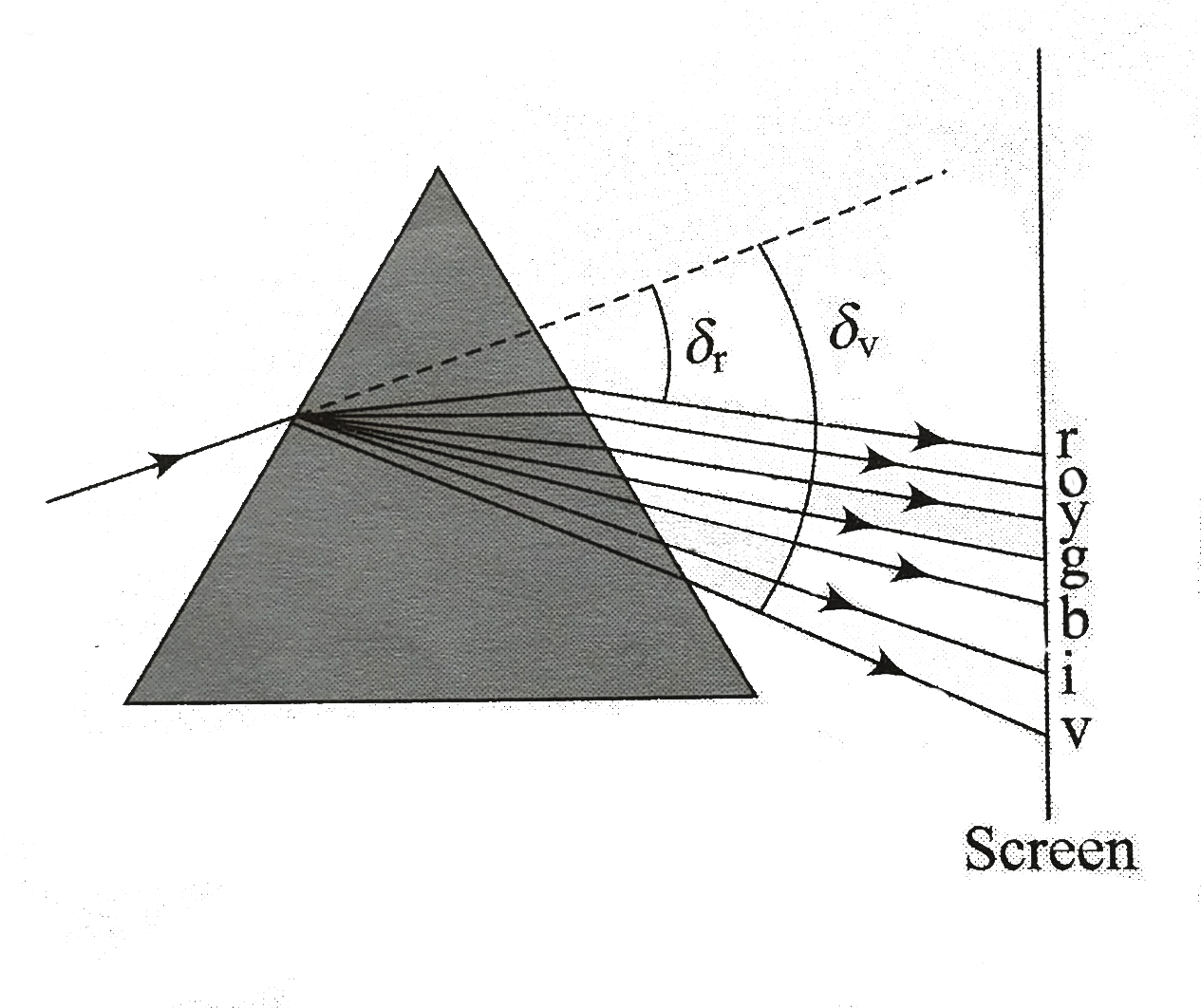Calculate (a) the refracting angle of a flint glass prism which should be combined with a crown glass prism of refracting angle 6° so that the combination may have no deviation for D line and (b) the angular separation between the C and F lines, given that the refractive indices of the materials are as follows:

Let A1 and A2 be the refracting angles of the flint and crown glass prisms respectively. μ1 and μ2 be the refractive indices for the D line of flint and crown glasses respectively. (a) If δ1,andδ2, be the angles of deviations due to the flint and crown glass prisms respectively, then for no deviation of D line
δ1+δ2=0,A1(μ1−1)+A2(μ2−1)=0
A1A2=−(μ1−1μ1)
The negative sign indicates that A1 and A2 are oppositely directed.
A160=(1.530−11.795−1),A1=60×0.5300.795=−4∘
(b) Angular dispersion due to the flint glass prism
=A1(μF−μC)2=6∘(1.535−1.527)=0.048
Net angular dispersion = 0.048 -0.060 = -0.012 The negative sign indicates that the resultant dispersion is in the direction of the deviation produced by the flint prism.
Topper's Solved these Questions
- RAY OPTICSBOOK - AAKASH SERIESCHAPTER - RAY OPTICSEXERCISE - EXERCISE (LONG ANSWER QUESTIONS )
9 Videos
- RAY OPTICSBOOK - AAKASH SERIESCHAPTER - RAY OPTICSEXERCISE - EXERCISE (SHORT ANSWER QUESTIONS )
24 Videos
- PRACTICAL PHYSICSBOOK - AAKASH SERIESCHAPTER - PRACTICAL PHYSICSEXERCISE - LECTURE SHEET LEVEL-II (ADVANCED) Linked Comprehension Type Questions
4 Videos
- SEMICONDUCTOR DEVICESBOOK - AAKASH SERIESCHAPTER - SEMICONDUCTOR DEVICESEXERCISE - EXERCISE - III
3 Videos
Similar Questions
Find the angle of the flint glass prism which should be combined with a crown glass prism of 6∘ so as to give dispersion but no deviation.
For crown glass,μv=1.520,μR=1.48
For flit glass, μv=1.78,μR=1.72
View SolutionA prism of crown glass with refracting angle of 5∘ and mean refractive index = 1.151 is combined with a flint glass prism of refractive index = 1.65 to produce deviation. Find the angle of fliint glass.
View Solution
Knowledge Check
The angle of minimum deviation for a glass prism with μ=√3 equals the refracting angle of the prism. What is the angle of the prism?
A45∘B30∘C90∘D60∘
We have to combine a crown glass prism of angle 4∘ with a flint glass prism in such a way that the mean ray passes undeviated, find (i) the angle of the flint glass prism needed and (i) the angular dispersion produced by the combination when white light goes through it. Refractive indices for red, yellow and violet light are 1.514, 1.517 and 1.523 respectively for crown glass and 1.613, 1.620 and 1.632 for flint glass.
View SolutionA crown glass prism of angle 5∘ is to be combined with a flint glass prism in such a way that the mean ray passes undeviated. Find (a) the angle of the flint glass prism needed and (b) the angular dispersion produced by the combination when white light goes through it. Refractive indices for red, yellow and viloet light are 1.514, 1.517 and 1.523 respectively for crown glass and 1.613 1.620 and 1.632 for flint glass.
View SolutionThe angle of minimum deviation for a glass prism with μ=√3 equals the refracting angle of the prism. What is the angle of the prism?
View SolutionThe angle of minimum deviation for a glass prism with μ=√3 equals the refracting angle of the prism. What is the angle of the prism?
View SolutionThe angle of minimum deviation for a glass prism with μ=√3 equals the refracting angle of the prism. What is the angle of the prism?
View SolutionA thin prism of angle A=6∘ produces a deviation d=3∘. Find the refractive index of the material of prism.


View SolutionThe least angle of deviation for a glass prism is equal to its refracting angle. The refractive index of glass is 1.5. Then the angle of the prism is
View Solution